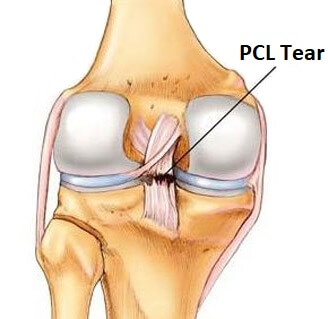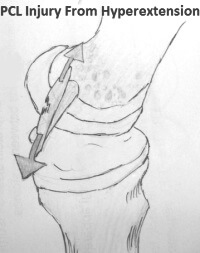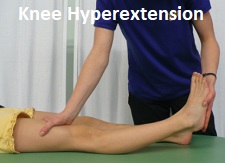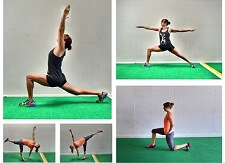- Home
- Common Knee Injuries
- PCL Injury
PCL Injury
Written By: Chloe Wilson, BSc(Hons) Physiotherapy
Reviewed by: KPE Medical Review Board
A PCL injury occurs when the posterior cruciate ligament of the knee gets overstretched and tears. Diagnosing PCL injuries is difficult and tears are frequently missed.
The posterior cruciate ligament is one of the main stabilizing ligaments of the knee.
PCL injuries most commonly occurs when there is a sudden force through the top of the shin bone, when the knee hyperextends (bends too far back) or occasionally from a twisting injury. PCL injuries are much less common than ACL injuries.
Here, we will look at the role of the posterior cruciate ligament, how it gets damaged and the symptoms, diagnosis and treatment options for a PCL injury.
What is the PCL?
The posterior cruciate ligament is one of a pair of ligaments, along with the anterior cruciate ligament, that sit in the middle of the knee joint. They join the femur to the tibia (thigh bone to shin bone) and control the stability of the knee.
The PCL is the stronger of the two cruciate ligaments, and as a result is much less commonly damaged than the ACL.
The job of the posterior cruciate ligament is to stop the tibia (shin) from moving back too far in relation to the femur (thigh).
PCL Injury Mechanism
What causes a PCL injury? A posterior cruciate ligament injury happens when a powerful force goes through the top of the tibia, pushing it backwards and thus stretching the posterior cruciate ligament.
PCL injuries are usually caused by:
- Car Accident: Dashboard injuries, where the knee is bent and the shin hits the car dashboard pushing the knee into hyperflexion is the most common cause of PCL tears
- Fall: Falling onto a bent knee with the foot pointing downwards is the most common sporting PCL injury
- Sporting Tackle: sometimes the posterior cruciate ligament can be injured during an awkward tackle when the knee is bent
- Hyperextension: the posterior cruciate ligament can also be damaged by the knee bending too far backwards
PCL Injury Symptoms
The most common PCL injury symptoms include:
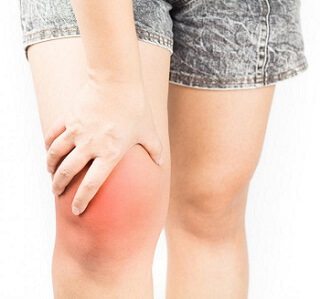
- Pain: pain from a pcl tear is usually mild to moderate and may affect how you walk. Squatting is usually painful, particularly at approximately ninety degrees of knee flexion. Resisted knee flexion typically causes pain
- Swelling: in the knee is usually mild to moderate. It tends to come on rapidly in the first few hours after injury. There may also be mild, slow swelling of the calf due to a synovial tear where the fluids slowly seeps downwards into the calf
- Instability: the knee may feel slightly unsteady or like it is going to give-way after a posterior cruciate ligament injury, but it is rare that it actually does collapse
- Difficulty with Activities: most commonly running (especially the initial push-off phase), anything on a bent knee (e.g. stairs), lifting heavy objects and taking off your shoes. Walking may feel "wrong".
The symptoms of a PCL injury are sometimes quite mild, and as a result it often goes unnoticed. Lingering problems with the knee not feeling quite right are often what leads to a diagnosis.
Diagnosing a PCL Knee Injury
The doctor can usually diagnose a PCL injury from examining your knee to see if the shin bone moves back too far when the knee is bent.
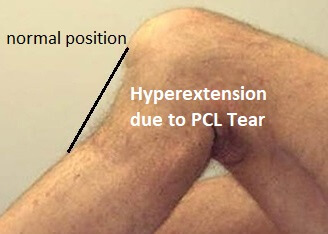
In a resting position with the knee bent, there should be a continuous, flat line from the kneecap down the shin. You can see in the picture here that the top of the shin bone has dropped backwards behind the normal line, a classic sign of a posterior cruciate ligament tear.
An MRI may be done to confirm the diagnosis but with a chronic PCL injury, one that you’ve had for a long time, an MRI may appear normal, despite continuing laxity in the ligament.
An x-ray may be done if an avulsion fracture is suspected with your pcl tear – where the ligament has torn off from its attachment bringing a small fragment of bone with it.
One simple test you can do to self-diagnose a posterior cruciate ligament tear is to stand upright and bend your knee to around ninety degrees. If that causes pain, rest your leg down, draw your toes upwards as much as you can (dorsiflexion) and repeat the knee flexion keeping the toes pulled up. If the pain is significantly less, it indicates a PCL injury.
Grades of PCL Tear
With a posterior cruciate ligament injury, as with all ligament injuries, there are three different grades of injury. The higher the grade of injury, the longer it will take to recover.
A pcl sprain can be classified as:
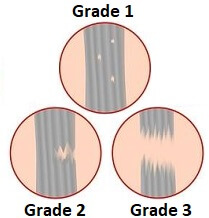
Grade 1: Minor injury with less the 10% of the fibres being damaged
Grade 2: Moderate injury with more of the fibres being torn
Grade 3: Major injury with the entire ligament being torn, known as a rupture.
Sometimes, other structures may be damaged at the same time as the pcl, such as another knee ligament, cartilage tear or a knee knee dislocation.
PCL Tear Treatment
So how long does it take to recover from a PCL tear? Most PCL knee injuries are grade 1 or 2 and will heal naturally without the need for surgery within a few weeks. With grade 3 injuries, surgery is often required and it can take months to make a full recovery.
With a grade 1 and 2 PCL injury, recovery usually takes 6-12 weeks. PCL tear treatment usually consists of:
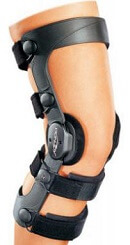
- Knee Brace: your doctor may recommend wearing a knee brace initially to help stabilize the knee and prevent further damage. Find the right one for you in the knee brace section
- Regular Ice: the help reduce the swelling and discomfort. Find out how to safely and effectively use this in the ice treatment section
- Compression: to reduce swelling such as tubigrip compression bandage
- Exercises: physical therapy to regain the strength, particularly of the quadriceps, mobility and stability of the knee is vital to ensure a full recovery and to prevent any long-term instability which can lead to arthritis
People often ask if a completely torn PCL can heal on its own. Unfortunately the answer is no, but it may be possible to build up enough stability that you can live without a functioning posterior cruciate ligament without having it surgically repaired.
Posterior Cruciate Ligament Surgery
With more severe posterior cruciate ligament injuries, surgery may be required. This is usually
advised if there are associated injuries e.g. damage to other ligaments
or patellar dislocation, avulsion injuries, where a piece of bone has
broken off, and chronic cases of long-term instability despite adequate
rehabilitation.
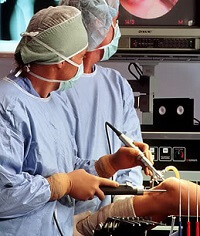
PCL surgery is usually carried out arthroscopically, keyhole surgery, and involves replacing the damaged ligament with a new one, known as a graft, usually fashioned from other tissue such as the patellar or hamstrings tendon.
If the pcl tendon is intact but has torn of part of the bone, it will simply be reattached with screws.
Surgery tends to be more successful when carried out soon after the PCL injury. Following surgery you will work on a rehab programme with a physical therapist and it can take 6-12 months to fully recover.
Ongoing Problems After PCL Tear
A PCL injury often goes undiagnosed as the symptoms tend to be fairly mild. If you are having ongoing problems with the stability of your knee, or it just doesn’t feel quite right, get it looked at by your doctor, you may have a pcl tear.
Page Last Updated: 10/01/23
Next Review Due: 10/01/25
Related Articles
References
1. The Archives of Bone and Joint Surgery: Posterior Cruciate Ligament: Current Concepts Review. S. Pache, Z. Aman, M.Kennedy, G. Yoshinobu Nakama, G. Moatshe, C. Ziegler, R. LaPrade. January 2018
2. Current Reviews in Musculoskeletal Medicine: Nonoperative Treatment of PCL Injuries: Goals of Rehabilitation and the Natural History of Conservative Care. D. Wang, J.Graziano, R. Williams, K. Jones. June 2018
3. WebMD: Posterior Cruciate Ligament Injury. T. Wheeler. February 2018
